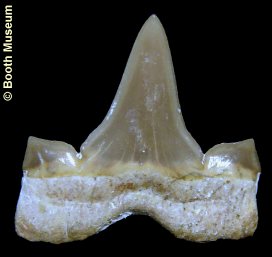 A A |
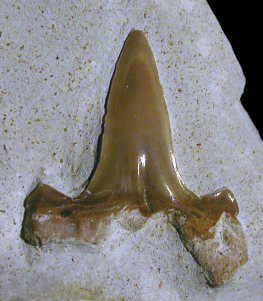 B B |
|
OTODONTIDS |
The extinct otodontids include the familiar Cretalamna appendiculata, perhaps the most commonly encountered shark tooth in the Chalk. The classic C. appendiculata form comprises a medium sized, labio-lingually flattened, tearing / cutting tooth, with a relatively tall, broad, triangular main cusp sided by well developed broad, triangular accessory cusps. The root is broad and low, with distinctive square root halves separated by a narrow, shallow basal notch.
The broader membership of the Otodontidae is not well resolved. Dwardius is variably included in the otodontids, Cretoxyrhinids, or as Lamniform Family incertae sedis (uncertain placement), and may also be very close to Cardabiodon. Dwardius teeth can be characterised as slightly larger and less labio-lingually flattened versions of Cretalamna, with more rounded and pointed root halves, and a broader basal notch. The lingual face of the main cusp is more strongly convex, and the lingual protrusion is well developed.
Paraisurus is currently included here amongst the Otodontids, though this is questionable and Lamniform Family incertae sedis may be a more appropriate classification. Serratolamna is also questionably included here (advanced root structure may suggest they belong elsewhere).
 A A |
 B B |
1). (A) Cretalamna ex. gr. appendiculata - Labial view of a classic Cretalamnid anterior tooth (anterior position indicated by upright main cusp) displaying the typical broad accessory cusps and square profile to the root halves (x5.0, White Chalk, Booth Museum, BMB 024350, by kind permission of John Cooper); (B) Cretalamna sp. - Labial view of a large anterior tooth (x3.0, Grey Chalk (channel lag deposit in West Melbury Marly Chalk), Southerham, near Lewes, Randell Collection RR0046).
 A A |
 B B |
2). Cretalamna ex. gr. appendiculata - Lingual views of an anterior teeth (upright main cusp) displaying the typical well-defined accessory cusps and square profile to the root halves; (A) x4.3, White Chalk, Booth Museum, BMB 024339, by kind permission of John Cooper; (B) x2.9, Grey Chalk, Eastbourne, Alan Prowse Collection, by kind permission.
|
|
|
|
3). Dwardius woodwardi: (A) Lingual, (B) side and (C) labial views of large latero-anterior teeth. Note well developed accessory cups, well separated and rounded root halves, rounded open angle of the basal edge, convex lingual surface, small foramen on the pronounced and swollen lingual protrusion, and medially expanded lingual neck. A,B) x2.7, Chalk, Sussex, [Dixon Collection], NHMUK (British Museum (Natural History) London) PV P25799/25800/25946?; C) x2.6, Grey Chalk, Burham, Kent, NHMUK (British Museum (Natural History) London) PV P49635. Images © 2012 The Natural History Museum, by kind permission.
4). Dwardius woodwardi - A large association of well preserved teeth, evidently from a single individual (x1.4, Zig Zag Chalk, near Maidstone, Kent, NHMUK (British Museum (Natural History) London) PV P39053). Image © 2012 The Natural History Museum, by kind permission.
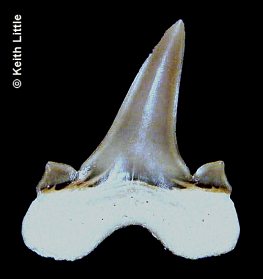 A A |
 B B |
5). Cretalamna ex. gr. appendiculata - (A) Labial and (B) lingual views of an isolated tooth (x4.0, 'Margate' Chalk (Newhaven Chalk equivalent) Palm Bay, near Margate, Kent, Keith Little Collection, by kind permission).
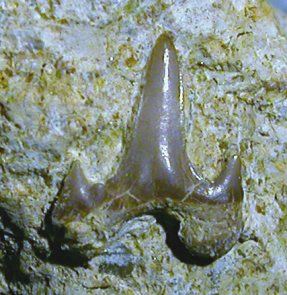 A A |
 B B |
6). Cretalamna ex. gr. appendiculata - (A) Labial view of a small anterior tooth (x8.6, Grey Chalk (channel lag deposit in West Melbury Marly Chalk), Southerham, near Lewes, Randell Collection RR0046); (B) Labial view of a latero-posterior tooth (distally inclined main cusp) (x5.0, Grey Chalk (channel lag deposit in West Melbury Marly Chalk), Southerham, near Lewes, Randell Collection RR0046).
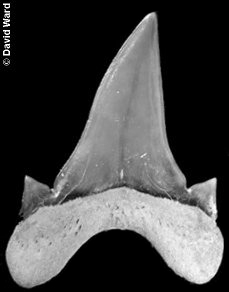 A A |
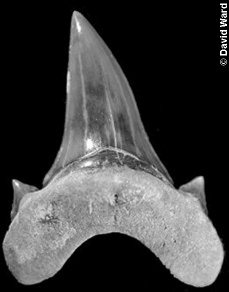 B B |
7). Dwardius sp. - (A) Labial and (B) lingual views of a medium-sized isolated tooth from the Albian Gault Clay, Squerry's Pit, David Ward Collection - note well developed accessory cups, well separated and rounded root halves, rounded open angle of the basal edge, convex lingual surface, small foramen on the lingual protrusion, and medially expanded lingual neck (x3.5). Images by kind permission of David Ward. See also www.gaultammonite.co.uk [Fossils of the Gault Clay].
 A A |
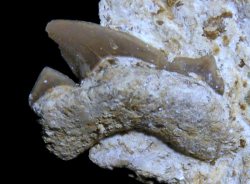 B B |
8). Cretalamna ex. gr. appendiculata - (A) Anterior tooth possessing slightly atypical root halves, being more pointed than square ((x6.0, Grey Chalk?, Bostal Road Pit, Steyning, West Sussex, Randell Collection RR0644).; (B) Extreme latero-posterior tooth (x6.0, Grey Chalk (channel lag deposit in West Melbury Marly Chalk), Southerham, near Lewes, Randell Collection RR1575).
 A A |
 B B |
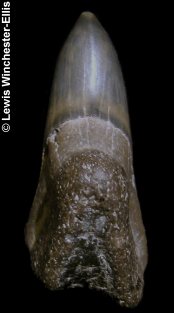 C C |
9). Paraisurus macrorhiza - Example tooth from the Albian Gault Clay of Folkestone - large tooth lacking tips to root halves, note highly convex lingual surface with a pronounced lingual protrusion. (A) Side, (B) labial and (C) lingual views (x3.0, Lewis Family Collection). Images mages used by kind permission of Lewis Winchester-Ellis.